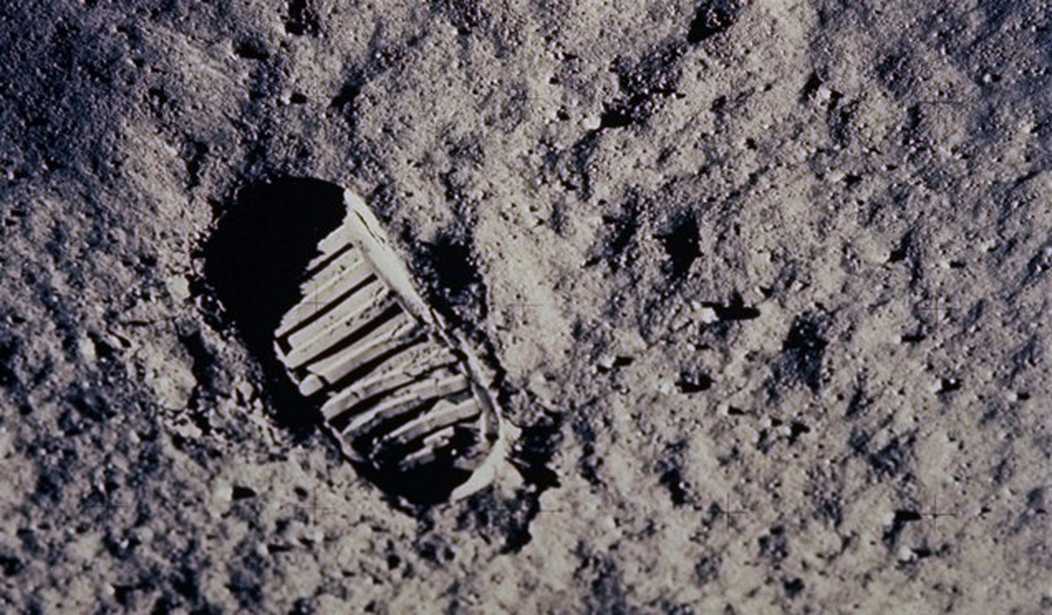Note: Most Thursdays, I take readers on a deep dive into a topic I hope you'll find interesting, important, or at least amusing. These essays are made possible by — and are exclusive to — our VIP supporters. If you'd like to join us, take advantage of our 60% off promotion.
Imagine a future where a hostile power builds the first Moon base — not in a movie, but in our lifetime. A dusty outpost on the lunar surface, bristling with sensors, antennas, and even weapons, watching everything that happens on Earth and in orbit from 240,000 miles up. Control of Luna means dominance over Earth's orbital space, threatening the satellites that provide everything from internet connectivity to missile defense.
All that might seem like pulp science fiction to some people, but today we live in a virtual science fiction age of reusable spaceships, instant global communications via thousands (soon, tens of thousands) of satellites, space-based missile defense, and a race back to Luna between two rival powers.
But this time, the race isn't to merely plant a flag for prestige and bragging rights. The race is on to establish a permanent and (eventually) self-sustaining presence on the ultimate high ground — and the gateway to the riches of the asteroid belt.
Right now, we're losing.
Losing is not the same as lost, however, so let's take a look at where we stand versus China.
Three-month-old me was asleep in a crib when Neil Armstrong put the first human footprint in the lunar dust and said, "That's one small step for a man, one giant leap for mankind." So it's impossible for me — and I'm among the oldest people who can say this — to have known a world where man hadn't set foot on the moon.
That was 56 years, one month, and one day ago.
Still, the only footprints on the moon are American. The only flags planted by human hands remain the Stars and Stripes.
So it's nearly impossible for me to imagine that the next set of footprints will be Chinese, and the next flag that of the Chinese Communist Party.
Yet that's the conclusion of space reporter Eric Berger — the best in the business by far — because, as he put it, "At this point, it's difficult to come to any other conclusion."
"In recent weeks," Berger reported Monday for Ars Technica, "the secretive Chinese space program has reported some significant milestones in developing its program to land astronauts on the lunar surface by the year 2030."
Two weeks ago, China successfully tested its 26-ton "Lanyue" lunar lander. Then on Friday of last week, China also "successfully conducted a 30-second test firing of the Long March 10 [LM-10] rocket's center core with its seven YF-100K engines that burn kerosene and liquid oxygen."
Those two tests followed a test in June of the Mengzhou spaceship's launch escape system. A lunar variant of Mengzhou will take taikonauts to the moon — before 2030, Beijing says.
"China's space program is making demonstrable progress in all three of the major elements of its lunar program: the large rocket to launch a crew spacecraft, which will carry humans to lunar orbit, plus the lander that will take astronauts down to the surface and back," Berger wrote.
"This work suggests that China is on course to land on the Moon before the end of this decade."
And where are we? Like they say on Facebook, "It's complicated."
On May 25, 1961, President John F. Kennedy set a goal of "landing a man on the moon and returning him safely to the earth," and completing that near-impossible mission "before this decade is out." Armstrong and Buzz Aldrin became the first men on the moon — while Michael Collins orbited the command module that would return all three safely home — just eight years later, on July 20, 1969.
We would have made it to the moon with a year or more to spare had it not been for the tragic Apollo 1 fire that killed Gus Grissom, Ed White, and Roger B. Chaffee during a 1967 launch rehearsal.
Apollo required just eight years, one month, and 29 days from "challenge accepted" to "mission accomplished," when all three men splashed down in the Pacific Ocean. That's 2,982 days.
They did it using technology that looks downright primeval to modern eyes — yet much of it didn't even exist when Kennedy issued his challenge.
So let's say that 2,982 days equals one "Apollo" or the length of time it takes a determined country that has no lunar program to create one from scratch and complete its first mission.
On Jan. 14, 2004, President George W. Bush announced his Vision for Space Exploration (VSE), setting a new direction for NASA following the loss of a second Space Shuttle — the Columbia —and all seven astronauts — the previous year.
The shift called for the retirement of the remaining Shuttles once the International Space Station was completed in 2011. NASA was tasked with building the Crew Exploration Vehicle (CEV), later renamed Orion, and redirected to focus on deep-space exploration and a return to the moon.
VSE became the Constellation program, marrying Orion to the new Ares I rocket (for manned launches) and the planned Altair lunar lander. The program also included an Ares V heavy cargo launch rocket, capable of putting enough stuff on the lunar surface for a permanent settlement there. Once completed, the solar system awaited.
The strategy was "Moon first, then Mars."
The goal was to get back to the moon "by 2020," and proceed from there. Assuming no major delays, let's say that Constellation would have put Orion and its crew of four on Luna on Dec. 31, 2019.
For those keeping score at home, Bush's VSE needed 5,829 days, or 1.95 Apollos. Considering the improvements in rocketry, materials technology, computing power, and all the rest, Bush's timeframe should have been considered as unacceptable as it was lackadaisical.
What happened next — or perhaps I should say, "What didn't happen next" — was even worse.
Constellation was a dud.
The Government Accountability Office (GAO) and NASA’s reviews warned that the program's budget was underestimated and the schedule was unrealistic. By the late 2000s, Ares I was years behind schedule, and Ares V was still on the drawing board.
President Obama, in 2009, convened his Review of U.S. Human Spaceflight Plans Committee, which concluded Constellation was “on an unsustainable trajectory" due in no small part to NASA needing an extra $3 billion annually. That would have been an annual budget increase of just 1.5 days' worth of Medicare/Medicaid spending, but even that little was too much.
Obama canceled Constellation in 2010.
And Another Thing: I must give credit where it's due. When Obama canceled Constellation, he also directed NASA to develop the commercial crew transport that led to the hugely successful SpaceX Crew Dragon capsule. Crew Dragon flights to the ISS provide SpaceX with the manned spaceflight experience the company needs to further its ambitions — and ours. Stick a pin in that thought; I'll come back to it further down.
President Donald Trump revealed in 2017 his Space Policy Directive 1, the first of six Space Policy Directives issued during his first term. That led to the initiation of the Artemis Program with the goal of getting us back to the moon — to stay — by 2030.
If you're still keeping score at home, that's 3.18 Apollos since Bush's VSE.
Artemis is a hot mess, in no small part because it relies on the Space Launch System (SLS) — a Frankenrocket built out of customized Delta rocket bits and leftover Space Shuttle parts. SLS was designed to keep contractors happy, not to be the best lunar rocket.
Despite using leftovers and old designs, SLS costs an eye-watering $4.2 billion per launch, and that does not include development costs. We simply can't afford SLS.
Nevertheless, Artemis I — an unmanned trip around the moon — flew on SLS in 2022. Artemis II — a manned version of the same trip, no landing — is scheduled for next year.
Because SLS lacks the lift needed to complete a lunar landing with Orion, Artemis relies on SpaceX's Starship (still in development) and dueling commercial lunar landers from SpaceX and Blue Origin (also still in development). SLS gets Orion to the Moon → Orion meets a commercial lander → astronauts ride lander down and back up → Orion returns them to Earth.
SpaceX also needs to perfect in-orbit refueling to get Starship+HLS lunar lander into lunar orbit.
And Another Thing: In-orbit refueling is a Very Big Deal. Apollo could only barely get to the moon and back because of the massive fuel requirements just to get everything into LEO. But that Saturn V also had to carry all the fuel the Command/Lunar modules needed to get to the moon and back. The plan for Starship is to launch orbital gas stations (also based on Starship), allowing a much (much!) bigger and heavier lander to "fill'er up" before proceeding to the moon.
Artemis III is supposed to happen in 2027, but good luck with that.
Let's set aside the failed or stalled programs and the technology and talk about the psychological and geopolitical effects of China beating us back to the moon.
"The geopolitical shock would be profound," James Pethokoukis wrote this week. "Dean Cheng, a longtime China-space analyst [formerly with the Heritage Foundation], warns in the Berger piece that a Chinese first step 'means the end of American exceptionalism.'" Around the world, Cheng added, losing the New Space Race would indicate that “China can do ‘big’ things, and the United States cannot.”
More from Pethokoukis:
"For All Mankind" on Apple TV+ vividly dramatizes such a stomach-churning moment against the backdrop of the 1960s Space Race. When cosmonaut Alexei Leonov becomes the first human on the Moon in the show’s alternate history, it gives the USSR a huge propaganda and political boost. The Soviets claim moral and ideological victory, touting the Soviet system as superior. (Leonov: “I take this step for my country, for my people, and for the Marxist-Leninist way of life, knowing that today is but one small step on a journey that will take us all to the stars.”)
Surely, communist China will do the same. So brace yourself.
As I write these words, it's been 2.65 Apollos since Bush announced VSE, and we still aren't on the moon — I have braced myself. We don't even have a rocket, a command module, or a lunar lander ready to go. That's the problem with nebulous timeframes with little leadership pushing to make them happen: they don't happen.
Or maybe that's a bit too harsh, because so far, I've focused on China's strengths and our weaknesses.
Now it's time to turn the tables.
While China is moving quickly and, dare I say it, far more confidently, its program appears to be a slightly updated version of our six-decade-old Apollo program.
Here's more from that Berger article I linked to above:
The initial phases of the Chinese program look derivative of Apollo, particularly a lander that strikingly resembles the Lunar Module. NASA can justifiably point to its Artemis Program and say it is attempting to learn the lessons of Apollo—that the program was canceled because it was not sustainable. With its lunar landers, NASA seeks to develop in-space propellant storage and refueling technology, allowing for lower cost, reusable lunar missions with the capability to bring much more mass to the Moon and back. This should eventually allow for the development of a lunar economy and enable a robust government-commercial enterprise.
As previously discussed, the Chinese Lunar Exploration Program (CLEP), just like Apollo, has three main parts: A rocket (LM-10), a command module (Mengzhou), and a lander (Lanyue). Also just like Apollo, CLEP's vehicles can't deliver much to the lunar surface aside from two taikonauts.
LM-10 can put just 70 metric tons into LEO and 27 metric tons into Trans-Lunar Injection (TLI), compared to Apollo's Saturn V rocket, which could put 140 tons into LEO and 48 tons into TLI. Beijing is mum — of course — on CLEP's flight profile to Luna, but these constraints make it look as though their manned missions will initially have a very light footprint.
That isn't to say that CLEP's ambitions end with LM-10/Mengzhou/Lanyue. They'll get better, and they'll do so quickly — you can be sure China won't take a 60-year break from manned lunar missions like we did.
On our side, Trump wants to ditch SLS, and Starship flight tests will at long last resume later this month.
Musk hopes to get Starship launches down to $2 million per flight. Even if he's off by an order of magnitude, a single $20 million Starship launch would cost one-half of one percent of a single SLS launch. And with tons (heh) more lift, too. Starship is expected to put up to 150 metric tons into LEO, and (once orbital refueling is perfected), maybe 100 tons or more into TLI — all at a tiny fraction of the cost of China's LM-10.
And that's just for starters. SpaceX designed Starship for rapid iteration and constant improvement.
China, on the other hand, has yet to reuse a single rocket — not even the equivalent of SpaceX's workhorse Falcon 9 that's been in reuse since 2017. China might beat us back to the moon, but if Musk can work the kinks out of Starship, they'll have a very hard time getting to Luna with enough stuff to build the kind of presence envisioned by Artemis.
But China is working hard on its own reusable rockets, and Starship has yet to make it to orbit, much less to the moon.
"Americans love a winner and will not tolerate a loser," Gen. George S. Patton told the men of his Third Army before sending them to fight in France. "Americans play to win all the time. I wouldn't give a hoot in hell for a man who lost, and laughed."
If — when? — the losers are us, it's going to sting. But as Pethokoukis concluded in his Substack essay, losing the race back to the moon "could provide the very shock needed" to re-energize our ambition.
Elon Musk has that ambition, and it's fused into SpaceX's corporate DNA. It's Washington — and, yes, a majority of the American people — that seem to have lost it.
Good Lord, it's been nearly 6.5 Apollos since our last manned lunar mission returned safely to Earth — what happened to us?
If we lose the New Space Race, our entire space exploration program — manned and unmanned — might end up being nothing more than a series of scouting missions for the Chinese Communist Party. In a future essay, I'll show you how China is already militarizing space and how its current achievements would expand with a sizable lunar presence, unmatched by one of our own.
The risks would make the Cuban Missile Crisis look like Cuba Libres on the beach. But this time, the party would be Beijing’s, not ours. To those who say we can’t afford the Moon, I say we can afford anything but losing it. We can choose drift over lift, or we can choose to win. The choice is ours, at least for now.
Last Thursday: All That Jazz










